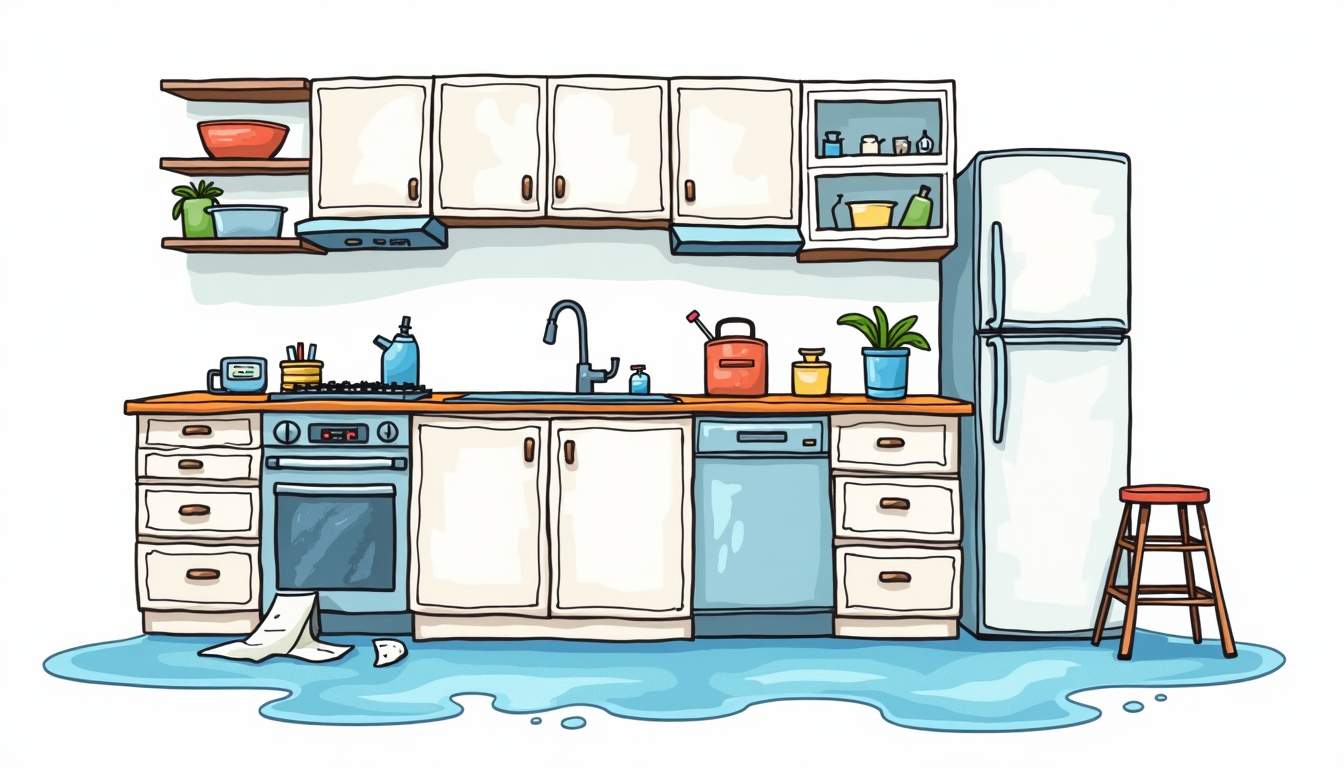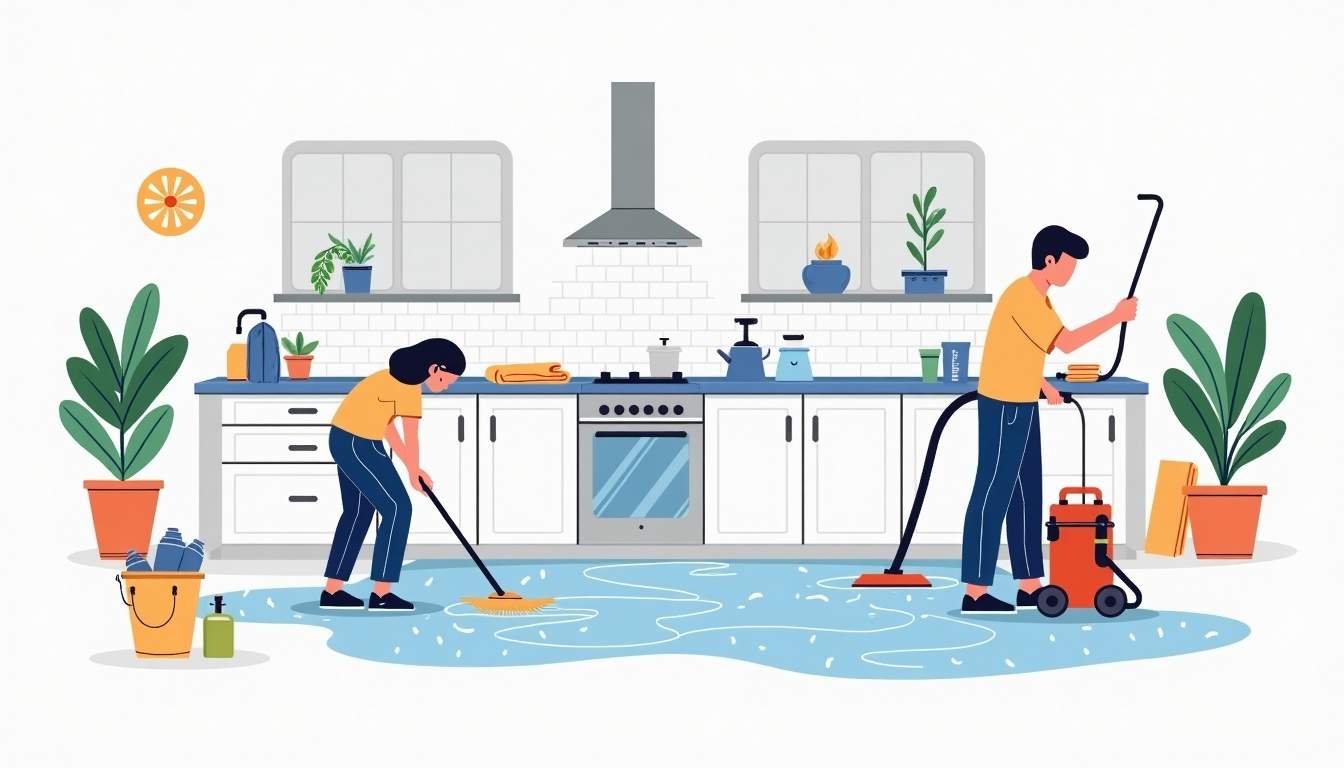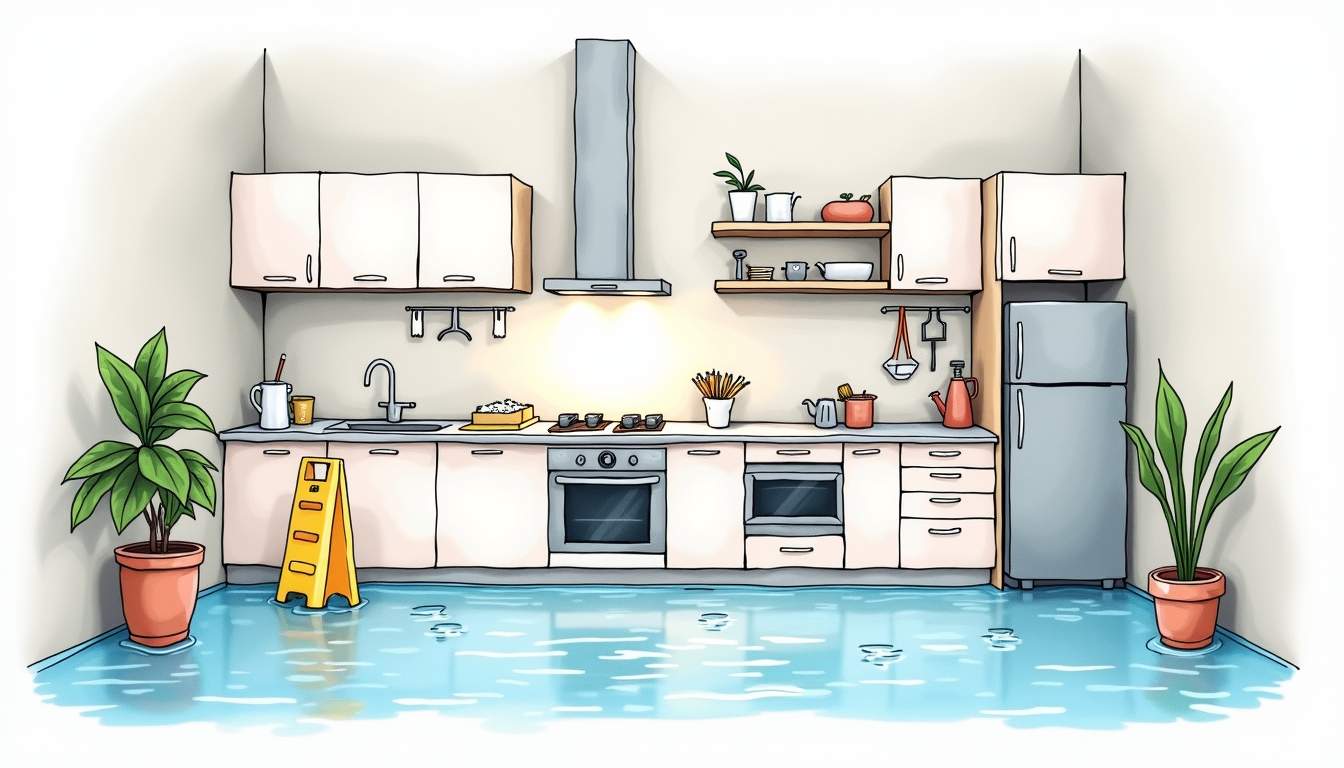The kitchen is often considered the heart of the home, a place where families gather to cook, eat, and share moments together. However, it’s also one of the most vulnerable areas when it comes to water damage and flooding. A kitchen flood can cause extensive damage, leading to costly repairs and significant disruption to daily life. Fortunately, with the right knowledge and proactive measures, many kitchen floods can be prevented, and if they do occur, the damage can be minimized.
This comprehensive guide explores effective kitchen flood prevention strategies and practical repair tips to help homeowners protect their kitchens from water damage. Whether you’re dealing with a minor leak or a major flood, understanding how to respond quickly and prevent future incidents is key to maintaining a safe and functional kitchen.
Common Causes of Kitchen Floods
Leaking or Burst Pipes
One of the most frequent causes of kitchen flooding is leaking or burst pipes. Over time, pipes can corrode, develop cracks, or become loose at the joints. When this happens, water can seep out slowly or gush suddenly, flooding the kitchen floor and damaging cabinets, appliances, and flooring.

Older homes with aging plumbing systems are particularly susceptible to pipe failures. Additionally, extreme temperature changes can cause pipes to freeze and burst, especially in colder climates. Regular inspection of visible pipes under sinks and behind appliances can help detect early signs of wear and tear. Homeowners should also consider insulating exposed pipes during winter months to prevent freezing, which could lead to costly repairs and extensive water damage.
Faulty or Clogged Appliances
Kitchen appliances such as dishwashers, refrigerators with ice makers, and washing machines are common culprits in kitchen floods. A malfunctioning appliance can leak water, sometimes unnoticed for hours or days, leading to significant damage.
Clogged dishwasher drains or refrigerator water lines can cause water to back up and overflow. Routine maintenance, including cleaning filters and hoses, can reduce the risk of appliance-related flooding. It’s also important to replace old or damaged hoses and ensure appliances are installed correctly. Many homeowners may not realize that the water supply lines to these appliances can also degrade over time, leading to leaks. Regularly checking for signs of wear, such as bulging or cracking in hoses, can help prevent unexpected floods. For expert help and reliable solutions, you can visit Plumber Singapore, a trusted, reliable, and professional plumbing services company offering affordable plumbing services across Singapore.
Clogged or Damaged Sinks and Drains
Slow or clogged drains can cause water to pool in the sink and overflow onto the kitchen floor. Grease buildup, food debris, and foreign objects often cause blockages. Additionally, damaged or improperly sealed sink basins and drain pipes can leak water beneath the cabinets.
Regularly cleaning sink drains and using strainers to catch food particles can prevent clogs. If water is pooling around the sink, it’s essential to check seals and plumbing connections for leaks or damage. Furthermore, homeowners may want to consider using enzymatic drain cleaners, which can break down organic material without harming the plumbing system. In cases of persistent clogs, it may be wise to consult a professional plumber who can perform a thorough inspection and provide solutions that go beyond simple DIY fixes.
Effective Kitchen Flood Prevention Tips
Regular Plumbing Inspections
Scheduling routine plumbing inspections is one of the most effective ways to prevent kitchen floods. Professional plumbers can identify weak spots, corrosion, or potential leaks before they become serious problems. Homeowners should also learn to recognize early warning signs such as damp spots, mold growth, or the sound of dripping water.
In addition to professional inspections, homeowners can perform basic checks themselves by examining visible pipes and connections under the sink and behind appliances. Tightening loose fittings and replacing worn-out washers can prevent leaks from developing.
Install Water Leak Detectors
Technology has made flood prevention more accessible with the advent of water leak detectors. These small devices can be placed near potential leak sources such as under the sink, behind the dishwasher, or near the refrigerator. When water is detected, the device emits an alarm or sends a notification to your smartphone, allowing for immediate action.
Some advanced systems can even automatically shut off the water supply to prevent flooding. Investing in water leak detectors provides peace of mind, especially for those who travel frequently or spend long hours away from home.
Maintain and Replace Appliance Hoses
Appliance hoses are often overlooked but are a common source of kitchen floods. Over time, hoses can become brittle, cracked, or loose, leading to leaks. It’s recommended to inspect hoses every six months and replace them every five years or sooner if signs of wear are evident.
Using high-quality, reinforced hoses can reduce the risk of bursts. When installing new hoses, ensure they are properly connected and secured to prevent leaks. Additionally, avoid kinking or bending hoses sharply, as this can weaken their structure.
Practice Proper Sink and Drain Care
Preventing clogs is crucial to avoiding sink overflows. Avoid pouring grease, oil, or coffee grounds down the drain, as these substances solidify and cause blockages. Instead, dispose of them in the trash or compost bin.
Using a drain strainer can catch food particles and prevent them from entering the plumbing system. Regularly flushing drains with hot water and a mixture of baking soda and vinegar can help break down buildup and keep pipes clear.
Seal and Waterproof Kitchen Surfaces
Water can seep into cabinets and flooring if seals around sinks, countertops, and appliances are compromised. Applying waterproof sealants around sink edges and backsplashes can prevent water from penetrating these vulnerable areas.
Check caulking regularly and replace it if it becomes cracked or missing. For kitchens with hardwood or laminate flooring, consider installing water-resistant materials or mats in areas prone to spills and leaks.
Steps to Take Immediately After a Kitchen Flood
Turn Off the Water Supply
The first and most critical step after discovering a kitchen flood is to stop the source of water. Locate the main water shutoff valve or the valve controlling water to the affected appliance and turn it off immediately. This action can prevent further flooding and limit damage.

Disconnect Electrical Appliances
Water and electricity are a dangerous combination. Before attempting any cleanup, unplug electrical appliances in the kitchen to avoid the risk of electric shock. If water has reached electrical outlets or appliances, it’s safest to turn off the power at the circuit breaker until the area is dry and inspected by a professional.
Remove Standing Water
Using mops, towels, or a wet/dry vacuum, remove as much standing water as possible. The quicker the water is removed, the less damage it will cause to cabinets, flooring, and walls. If the flood is severe, consider renting specialized water extraction equipment or hiring professional water damage restoration services.
Dry and Ventilate the Area
After removing standing water, thoroughly dry the kitchen using fans, dehumidifiers, and open windows to improve air circulation. Moisture left behind can lead to mold growth, which poses health risks and can further damage materials.
Assess and Document the Damage
Once the area is dry, inspect cabinets, flooring, walls, and appliances for damage. Take photographs and notes to document the extent of the flooding. This documentation is essential for insurance claims and for planning repairs.
Kitchen Flood Repair Tips
Address Structural Damage Promptly
Water can weaken cabinets, drywall, and flooring. If materials are swollen, warped, or crumbling, they may need to be replaced. Removing damaged drywall and insulation behind the walls can prevent mold growth. For hardwood floors, drying and refinishing may be possible if the damage is not extensive.
Clean and Disinfect Affected Areas
Flood water often contains contaminants, especially if the source is a burst pipe or appliance drain. Clean all affected surfaces with a disinfectant solution to kill bacteria and prevent mold. Pay special attention to hidden areas such as under cabinets and behind appliances.
Inspect and Repair Plumbing and Appliances
Identify and fix the cause of the flood before restoring the kitchen. This may involve repairing or replacing pipes, hoses, or appliances. Hiring a licensed plumber ensures that repairs meet safety standards and reduce the risk of future leaks.
Restore and Reinstall Kitchen Fixtures
Once repairs are complete and the area is dry, reinstall or replace cabinets, countertops, and flooring as needed. Consider upgrading to water-resistant materials to improve future flood resilience. Reconnect appliances and test them to ensure they operate safely and without leaks.
Long-Term Flood Prevention Strategies
Upgrade Plumbing Systems
Older plumbing systems are more prone to leaks and bursts. Upgrading to modern, durable piping materials such as PEX or copper can significantly reduce the risk of flooding. Additionally, installing shutoff valves for individual appliances allows for quick water isolation in case of leaks.

Implement Smart Home Water Monitoring
Smart water monitoring systems provide real-time data on water usage and detect leaks early. These systems can alert homeowners via smartphone apps and automatically shut off water supply if a leak is detected. Integrating these technologies into your kitchen can prevent minor leaks from turning into major floods.
Educate Household Members
Ensuring everyone in the household knows how to recognize signs of leaks and how to shut off the water supply can prevent floods from escalating. Simple knowledge like not pouring grease down drains and promptly reporting any plumbing issues can make a big difference.
Maintain Regular Cleaning and Inspections
Consistent upkeep, including cleaning drains, inspecting seals, and checking appliances, is essential for long-term flood prevention. Scheduling seasonal maintenance tasks helps catch potential problems early and keeps the kitchen plumbing in good condition.
Conclusion
Kitchen floods can be devastating, but with proactive prevention and prompt repair, the risks and damages can be minimized. Understanding the common causes of kitchen flooding, implementing effective prevention strategies, and knowing how to respond quickly after a flood are critical steps for protecting one of the most important spaces in the home.
Regular maintenance, smart technology, and informed household members create a strong defense against water damage. By investing time and effort into kitchen flood prevention and repair, homeowners can enjoy a safe, functional, and beautiful kitchen for years to come.








